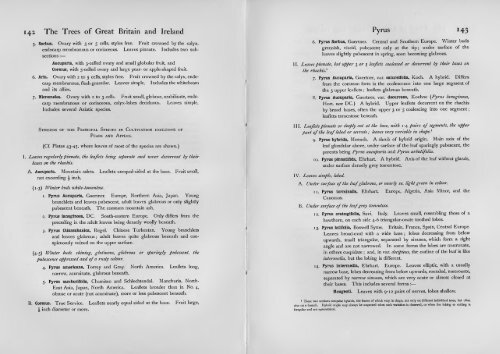the trees of great britain & ireland - Facsimile Books & other digitally ...
the trees of great britain & ireland - Facsimile Books & other digitally ...
the trees of great britain & ireland - Facsimile Books & other digitally ...
You also want an ePaper? Increase the reach of your titles
YUMPU automatically turns print PDFs into web optimized ePapers that Google loves.
142, The Trees <strong>of</strong> Great Britain and Ireland<br />
5. Sorbus. Ovary with 3 or 5 cells, styles free. Fruit crowned by <strong>the</strong> calyx,<br />
endocarp membranous or coriaceous. Leaves pinnate. Includes two sub<br />
sections :<br />
Aucuparia, with 3-celled ovary and small globular fruit, and<br />
Cormus, with 5-celled ovary and large pear- or apple-shaped fruit.<br />
6. Aria. Ovary with 2 to 5 cells, styles free. Fruit crowned by <strong>the</strong> calyx, endo<br />
carp membranous, flesh granular. Leaves simple. Includes <strong>the</strong> whitebeam<br />
and its allies.<br />
7. Micromeles. Ovary with 2 to 3 cells. Fruit small, globose, umbilicate, endo<br />
carp membranous or coriaceous, calyx-lobes deciduous. Leaves simple.<br />
Includes several Asiatic species.<br />
SYNOPSIS OF THE PRINCIPAL SPECIES IN CULTIVATION EXCLUSIVE OF<br />
PEARS AND APPLES.<br />
(Cf. Plates 43-45 where leaves <strong>of</strong> most <strong>of</strong> <strong>the</strong> species are shown.)<br />
I. Leaves regularly pinnate, <strong>the</strong> leaflets being separate and never decurrent by <strong>the</strong>ir<br />
bases on <strong>the</strong> rhachis.<br />
A. Aucuparia. Mountain ashes. Leaflets unequal-sided at <strong>the</strong> base. Fruit small,<br />
not exceeding \ inch.<br />
(1-3) Winter buds •white-tomentose.<br />
1. Pyrus Aucuparia, Gaertner. Europe, Nor<strong>the</strong>rn Asia, Japan. Young<br />
branchlets and leaves pubescent, adult leaves glabrous or only slightly<br />
pubescent beneath. The common mountain ash.<br />
2. Pyrus lanug-inosa, DC. South-eastern Europe. Only differs from <strong>the</strong><br />
preceding in <strong>the</strong> adult leaves being densely woolly beneath.<br />
3. Pyrus thianschanica, Regel. Chinese Turkestan. Young branchlets<br />
and leaves glabrous ; adult leaves quite glabrous beneath and con<br />
spicuously veined on <strong>the</strong> upper surface.<br />
(4-5) Winter buds shining, glutinous, glabrous or sparingly pubescent, <strong>the</strong><br />
pubescence appressed and <strong>of</strong> a rusty colour.<br />
4. Pyrus americana, Torrey and Gray. North America. Leaflets long,<br />
narrow, acuminate, glabrous beneath.<br />
5. Pyrus sambucifolia, Chamisso and Schlechtendal. Manchuria, North-<br />
East Asia, Japan, North America. Leaflets broader than in No. 4,<br />
obtuse or acute (not acuminate), more or less pubescent beneath.<br />
B. Cormus. True Service. Leaflets nearly equal sided at <strong>the</strong> base. Fruit large,<br />
inch diameter or more.<br />
Pyrus<br />
6. Pyrus Sorbus, Gaertner. Central and Sou<strong>the</strong>rn Europe. Winter buds<br />
greenish, viscid, pubescent only at <strong>the</strong> tip; under surface <strong>of</strong> <strong>the</strong><br />
leaves slightly pubescent in spring, soon becoming glabrous.<br />
II. Leaves pinnate, but upper 3 or 5 leaflets coalesced or decurrent by <strong>the</strong>ir bases on<br />
<strong>the</strong> rhachis^<br />
7. Pyrus Aucuparia, Gaertner, var. satureifolia, Koch. A hybrid. Differs<br />
from <strong>the</strong> common form in <strong>the</strong> coalescence into one large segment <strong>of</strong><br />
<strong>the</strong> 3 upper leaflets ; leaflets glabrous beneath.<br />
8. Pyrus Aucuparia, Gaertner, var. decurrens, Koehne (Pyrus lanuginosa,<br />
Hort. non DC.) A hybrid. Upper leaflets decurrent on <strong>the</strong> rhachis<br />
by broad bases, <strong>of</strong>ten <strong>the</strong> upper 3 or 5 coalescing into one segment;<br />
leaflets tomentose beneath.<br />
III. Leaflets pinnate or deeply cut at <strong>the</strong> base, with 1 -4 pairs <strong>of</strong> segments, <strong>the</strong> upper<br />
part <strong>of</strong> <strong>the</strong> leaf lobed or serrate; leaves very variable in shaped<br />
9. Pyrus hybrida, Moench. A shrub <strong>of</strong> hybrid origin. Main axis <strong>of</strong> <strong>the</strong><br />
leaf glandular above, under surface <strong>of</strong> <strong>the</strong> leaf sparingly pubescent, <strong>the</strong><br />
parents being Pyrus aucuparia and Pyrus arbutifolia.<br />
10. Pyrus pinnatifida, Ehrhart. A hybrid. Axis <strong>of</strong> <strong>the</strong> leaf without glands,<br />
under surface densely grey tomentose.<br />
IV. Leaves simple, lobed.<br />
A. Under surface <strong>of</strong> <strong>the</strong> leaf glabrous, or nearly so, light green in colour.<br />
11. Pyrus torminalis, Ehrhart. Europe, Algeria, Asia Minor, and <strong>the</strong><br />
Caucasus.<br />
B. Under surface <strong>of</strong> <strong>the</strong> leaf grey tmnentose.<br />
12. Pyrus cratsegifolia, Savi. Italy. Leaves small, resembling those <strong>of</strong> a<br />
hawthorn, on each side 4-6 triangular-ovate too<strong>the</strong>d lobes.<br />
13. Pyrus latifolia, Boswell Syme. Britain, France, Spain, Central Europe.<br />
Leaves broad-oval with a wide base ; lobes decreasing from below<br />
upwards, small triangular, separated by sinuses, which form a right<br />
angle and are not narrowed. In some forms <strong>the</strong> lobes are mucronate,<br />
in o<strong>the</strong>rs cuspidate ; and, in var. decipiens, <strong>the</strong> outline <strong>of</strong> <strong>the</strong> leaf is like<br />
intermedia, but <strong>the</strong> lobing is different.<br />
14. Pyrus intermedia, Ehrhart. Europe. Leaves elliptic, with a usually<br />
narrow base, lobes decreasing from below upwards, rounded, mucronate,<br />
separated by narrow sinuses, which are very acute or almost closed at<br />
<strong>the</strong>ir bases. This includes several forms :<br />
Mougeoti. Leaves with 9-12 pairs <strong>of</strong> nerves, lobes shallow.<br />
1 These two sections comprise hybrids, <strong>the</strong> leaves <strong>of</strong> which vary in shape, not only on different individual <strong>trees</strong>, but <strong>of</strong>ten<br />
also on a branch. Hybrid origin may always be suspected when such variation is observed, or when <strong>the</strong> lobing or cutting is<br />
irregular and not symmetrical.













